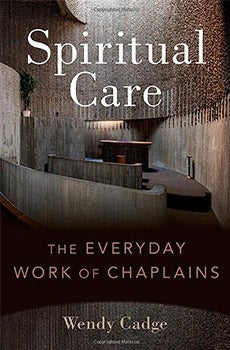Reviewed by Akpan Ubong-Abasi, Department of Religion
Chaplains are faith affiliated leaders who render a wide range of spiritual care and support services to groups and individuals in different settings they work, such as hospitals, prisons, armed forces units, schools amongst others.
In Spiritual Care: The Everyday Work of Chaplains, Wendy Cadge discusses the history, contemporary practices, and potential futures of chaplaincy. She also explores the various spiritual and religious traditions that chaplains represent, emphasizing the value of cultural sensitivity and expertise in this sector. Because of the changing religious demographics in the US, including the rise of people who are not affiliated with a particular religion or non-religious, Cadge argues that chaplains have become “strangely necessary figures in negotiating the public life of religion.” She uses Boston as a case study because of its cultural and religious diversity, the prominent medical centers in the city, and her deep knowledge of the city’s religious and cultural ecology, thereby allowing her to examine the complexities of chaplains working in pluralistic faith contexts in a wide range of settings.
In offering spiritual care for patients, family members and traumatized medical staff during the pandemic, chaplains came into national spotlight and in the conversation on religious pluralism. A 2019 national survey conducted by Cadge in the U.S finds 21% of the American public have had contact with a chaplain through healthcare and this increased during the Covid-19 pandemic.
Cadge argues that chaplains have helped been on the front lines of responding to contemporary changes in American religious demographics through their dynamic roles in the different settings they operate.
Remarkably, in the last 50 years, chaplaincy has shifted from being primarily dominated by a Catholic-Protestant men dominance to increasingly accommodating different genders and other religious affiliations. Today, chaplains work in varied settings, working across the United States in settings such as the armed forces, national guard, hospitals, rehabilitation centers, prisons, and institutions of higher learning. While in some settings, (military and prisons) chaplains care for specific religious groups and their work is heavily dictated by the institution guidance, in other settings, “chaplains neutralize religious differences, code switch and/or move between different religious and spiritual languages and registers, depending on who they are engaging with and to what end. (142)” There is also a wide diversity in how chaplains are trained, though the majority of chaplain have theological trainings, clinical pastoral education and over 80% are ordained ministers. Nevertheless, chaplains often help individuals and institutions negotiate religious differences, and they often serve a wide range of people, including people who are not religiously affiliated. Reflective of this diversity, chaplains are now recognized with phrases such as ‘spiritual care givers’, ‘spiritual advisors’, or “ministers without portfolio,” terms considered religiously inclusive.
Given religious and cultural change, Cadge argues that there is a need for chaplains to “speak universally,” even while being true to their specific faith. Cadge further highlights four categories of work that chaplains engage in: conducting rituals and ceremonies; offering individual support, especially in times of crisis; mediating and bridging differences within institutions; and simply being present as a form of spiritual care. In these roles, they uphold values of wholeness, presence, and hope. Often chaplain’s work is spontaneous, requiring chaplains to improvise to connect with the people they serve across faith and respond to emerging challenges. Cadge focuses on the centrality of death in the work of chaplains, describing them as people who often help people prepare to die, are present as people die, provide care to loved ones after death, and helping institutions manage death. In this way, chaplains are escorts through the dying process (113).
Despite focusing on the religious diversity of chaplains throughout her book, Cadge ultimately highlights on the experiences of Christian chaplains, who represent the majority of chaplains in the United States. This raises the question of whether this experience cuts across all traditions. Similarly, one would probe the blurry lines between chaplains and social workers, and if they are possibilities of complementing each other. Finally, the term ‘chaplain’ presents a Judeo-Christian register, and in light religious diversity in the US and globally, would there be an alternative term available that is generic to or inclusive of all religious traditions? Nevertheless, Cadge’s book raises important critical questions and conversations about the work of chaplains in different settings, as well as the future of American spiritual and religious life. It is clear that chaplains have a vital role to play in negotiating religion within many institutions in the United States at a time when we are witnessing substantial changes in religious demographics.

